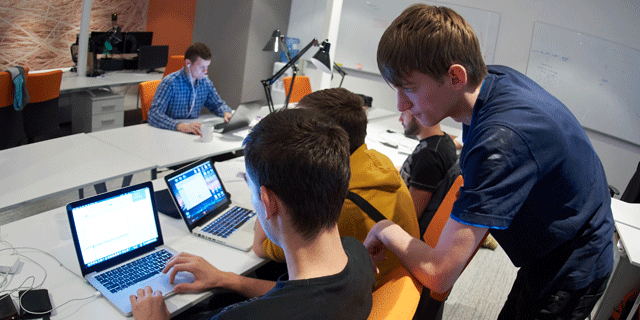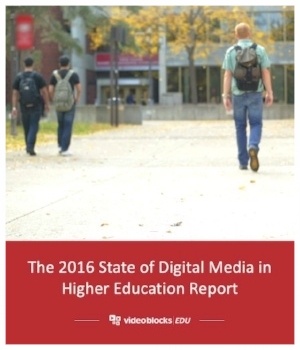
Is there a natural and organic way to incorporate digital literacy competencies and technical skills in the classroom—one that capitalizes on students already growing digital prowess and cultural awareness? One likely solution to this question is remix education.
In a recent post discussing the importance of digital literacy and why we need media in the classroom, we referenced the research of Doug Belshaw, whose work focuses on the crux of this very issue: how to make digital literacy both accessible and intuitive to all learners. For Belshaw, remix is the answer. In a recent TEDx talk given at the University of Warwick, he stated that “remix is so important that it’s right at the heart of digital literacies.” Essentially, remix culture and education lie at the very core of how to teach multimedia skills and critical thinking in the classroom.
Remix Is an Ongoing Cultural Conversation
At first glance, for many people the word “remix” recalls 90s hip hop or EDM music, and for some, it may even evoke early mainstream pioneers like Grandmaster Flash or Run—D.M.C. Yet, the idea behind remix is one that is much older than the 90s, embracing the perpetual and cyclical nature of innovation. Remix is simply a new way of describing the creative “call and response” that has existed in creative communities since their beginning.
In truth, as the video above from RiP!: A Remix Manifesto shows, artists and innovators have been remixing older ideas since the beginning of human history. From stories and artwork to political movements and theoretical ideals, nearly everything in our global culture is a rehashing, rebranding, repurposing, or recycling of what came before. Even the American dream—“life, liberty, and the pursuit of happiness”—as penned by Thomas Jefferson, is little more than a remix of John Locke’s assertion that government existed to protect citizens’ “life, liberty, and estate.”
Yet, despite the persistence of creative recycling throughout history, the era of remix is only just beginning. In many ways, it is only with the advent of digital media and technologies that we have begun to fully recognize the necessity and power behind remix education for teaching both digital literacy and cultural fluency.
Remix Culture is Digital Literacy
Media scholar and educator Eduardo Navas defines remix culture as a worldwide exchange of information and creative messages “made possible by digital technologies that is supported by the practice of cut/copy and paste.” Within Navas definition are two crucial points. First, remix is a part of a global creative exchange, aiding and mediated by technology. Second, the deliberate act of “cut/copy and paste”—which relies on core analytical and critical competencies, as creators and remix artists comprehend and synthesize cultural materials in order to synthesize their own works—becomes the paradigmatic and pedagogical framework for remix culture.
But what does remix in practice look like? It can take any number of forms, from pop cultural mashups to hip hop and EDM music sampling to incisive political photomontages. Each form of remix, in turn, relying on evolving technological and cultural literacies as the foundation of their medium and message.
Below is an example of how one student from Rowan University in New Jersey used the remix framework to create an audiovisual essay on income inequality by repurposing fragments of pop culture and current events.
So What Is Remix Education?
At its bare bones, remix education is a pedagogical approach that gives students the tools and critical approaches to communicate their own novel ideas, identities, and rhetoric through refashioned, retooled, and repurposed cultural objects. Put more simply, remix education empowers learners and students to express themselves thoughts through “recycled” culture and media, using preexisting objects—including music and video—as the building blocks for their own unique point of view.
What is essential about remix education is the digital literacies and competencies it requires from its students, which returns us to Doug Belshaw’s point. The reason that remix is such a vital pedagogical tool for digital literacy and media education is that it builds upon older skill sets and knowledge, as well-established forms of rhetoric, to create new meanings and messages. To this end, students gain a better understanding of the constituent parts—whether they’re remixing music, art, video, or theoretical constructs—while developing both vital analytical and technological skills.
Perhaps most importantly, remix capitalizes on skills and fluencies, from video editing to collaborative production processes, that have become increasingly essential for students in the modern world. Doug Sery, a new media scholar and MIT acquisitions editor, notes that remix education is vital for students because it teaches “systems thinking; connecting ideas information and experience, as well as collaboration—in the 21st century, those are the skills you will need to survive.”
The Next Step
Implementing remix education without digital media resources can be daunting, especially while also navigating the murky waters of copyright and fair use. VideoBlocks for Education is working hard to make quality, copyright-compliant media resources available to all learning communities with the Digital Backpack and our recently launched U-Curate content management platform.
To learn more about bringing premium media resources to your classroom or campus, please visit U-Curate.com or Download the U-Curate Product Overview.

